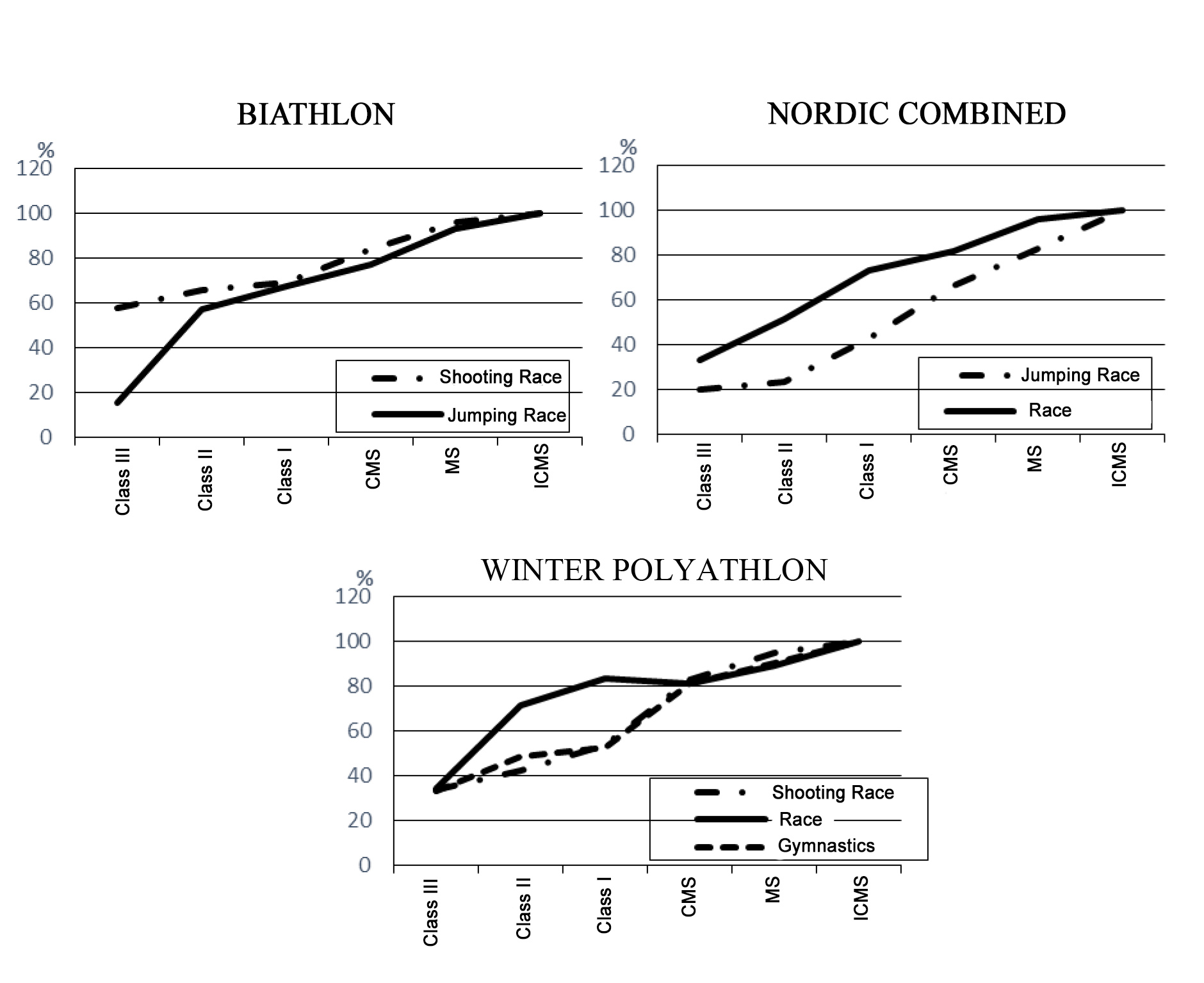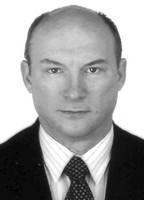Combined racing skiers' competitive fitness typing at sport mastery excellence stage
Фотографии:
ˑ:
Dr.Hab. V.V. Farbey1
Dr.Hab., Professor K.S. Dunaev2
1Herzen State Pedagogical University of Russia, St. Petersburg
2Moscow State Academy of Physical Culture, Malakhovka, Moscow region
Keywords: combined skiing events, competitive combined skiing exercises, sport classes, universal type of competitive fitness.
Background. The current competitive situation in modern sports and a clear competitiveness growth trend on the global sport arenas urge the sport analysts set new requirements to step up the efficiency of the long-term athletic training systems to achieve success in elite combined skiing sports. The long-term training systems should be updated to improve their efficiency with an emphasis on the goals, content, procedural components so that every training and competitive process element is duly designed and harmonized with the others.
In the modern sport system, combined skiing sports include a few specific sport disciplines (biathlon, Nordic combined events, winter polyathlon etc.) each having its own specific sets of exercises different in content and techniques. For success in the combined skiing events, the competitors need to achieve high fitness rates including special endurance, speed, speed-strength and coordination qualities and abilities.
As things now stand in the combined skiing events, the sports in general have come to a problematic situation as a result of a contradiction between the existing (largely imperfect) theoretical and practical basics for the long-term athletic training system designs and content and the need to step up the efficiency of the athletic training process control and management at every stage of the long-term athletic training process; with the actual success rates in the sports being largely dependent on how well the contradiction is resolved.
Objective of the study was to profile the combined skiing competitors’ sport excellence process versus their classified competitive fitness rates.
Study results and discussion. The study data and analyses demonstrate that the combined skiers normally come to success by the age of 20-22 years conditional on their skiing careers starting from 9-10 years of age as verified by the track record data of the Winter Olympics, all-Russian and World champions and finalists. It was also found that at least 11-13 years of intense training are required for a combined skier to reach the top mastery level. Regardless of the special skiing events the athletes specialize in, they normally go through virtually the same age-specific stages of the training process showing virtually the same competitive success growth at every stage.
For the last few decades the average age when the athletes come to the top mastery level has come down to 23-26 years. Analyses show that the average periods required to qualify for certain sport mastery categories are the following: 2.5, 3.1 and 5.8 years to make progress from Class I Athlete to Candidate Master of Sport (CMS); Master of Sport (MS); and International Class Master of Sport (ICMS), respectively.
Stages of the long-term athletic training process viewed as interconnected elements of an integrated sport excellence system may be described as the relatively complete periods of the athletic training process. The training process goals and content at every such stage are designed so as to provide a basis for the further sport excellence stages with due succession secured in the process. Each of the process stages is limited by a certain timeframe and competitive performance/ progress standards, i.e. the sport excellence growth factors. It is the consolidated competitive success rates that may be used to rate the competitive progress at every stage of the training process; and it is also important to rate contributions of every competitive exercise within one or another event of the combined skiing sport into the consolidated competitive success rate.
In our analyses of the skill-specific competitive progress data of the biathlon/ Nordic combined/ winter polyathlon competitors, we applied the best competitive success rates of the combined skiers qualified International Class Master of Sport as a 100% point on the success rating scale.
It should be noted that the skill-specific contributions of different competitive exercises of the combined skiing events into the consolidated competitive success rates were found different at each stage of the sport excellence process, with the gap between the Class III Athlete and ICMS contributions coming to as much as 80% in some cases: see Figure 1 hereunder.

Figure 1. Contributions of specific exercises of the combined skiing events into the skill-specific consolidated competitive success rates
Our analyses of the skill-specific contributions of different competitive exercises of the combined skiing events into the consolidated competitive success rates gave the grounds to type the competitive progress stages. We used the process/ interim sport progress rates in specific exercises of the combined skiing events and their contributions to the consolidated competitive success as the competitive progress rating criterion. By this competitive progress rating criterion, the skill-specific competitive fitness categories were typed as follows: in biathlon: universal competitor; racer; and shooter; in the Nordic combined events: universal competitor; jumper; and racer; and in winter polyathlon: universal competitor; gymnast racer; gymnast shooter; racer; shooter; and gymnast: see Table 1 hereunder.
Table 1. Skills-specific competitive fitness types of combined skiers
|
Types of combined skiers |
ICMS |
MS |
Class I to CMS |
Class II–III |
||||
|
n |
% |
n |
% |
n |
% |
n |
% |
|
|
Biathlon |
||||||||
|
Universal competitor |
30 |
55,6 |
32 |
38,6 |
37 |
33,0 |
31 |
21,5 |
|
Racer |
17 |
27,7 |
26 |
31,3 |
42 |
37,5 |
67 |
46,6 |
|
Shooter |
9 |
16,7 |
25 |
30,1 |
33 |
29,5 |
46 |
31,9 |
|
Nordic combined |
||||||||
|
Universal competitor |
16 |
48,5 |
31 |
37,4 |
31 |
37,8 |
24 |
32,8 |
|
Jumper |
9 |
27,3 |
29 |
34,9 |
36 |
43,9 |
32 |
43,8 |
|
Racer |
8 |
24,2 |
23 |
27,7 |
15 |
18,3 |
17 |
23,3 |
|
Winter polyathlon |
||||||||
|
Universal competitor |
25 |
27,2 |
35 |
25,7 |
21 |
12,8 |
16 |
13,3 |
|
Racer |
18 |
19,6 |
26 |
19,1 |
47 |
28,7 |
31 |
25,6 |
|
Shooting racer |
14 |
15,2 |
23 |
16,9 |
19 |
11,6 |
20 |
16,5 |
|
Gymnast racer |
12 |
13,0 |
8 |
5,9 |
26 |
15,8 |
15 |
12,4 |
|
Gymnast shooter |
9 |
9,8 |
22 |
16,2 |
21 |
12,8 |
15 |
12,4 |
|
Gymnast |
8 |
8,7 |
15 |
11,0 |
18 |
11,0 |
12 |
9,9 |
|
Shooter |
6 |
6,5 |
7 |
5,2 |
12 |
7,3 |
12 |
9,9 |
Note: n means the number of athletes
Conclusion. The study data and analyses showed that the number of the competitive fitness types tends to shrink with the growing skills of the combined skiers regardless of specific discipline within the combined skiing sports. The highly-skilled athletes are mostly classified with the universal competitor type showing the highest competitive fitness rates in every competitive exercise of the combined skiing disciplines. It was found that the sport excellence process of the combined skiers will be designed so as to build up the universal competitor type of the competitive fitness in the multistage training process.
References
- Dunaev K.S. Analiz sorevnovatelnoy deyatelnosti, kak faktor optimizatsii protsessa podgotovki rossiyskikh biatlonistov k otvetstvennym startam [Analysis of competitive activity as factor of optimization of Russian biathletes' pre-season training process]. Teoriya i praktika fiz. kultury, 2008, no. 2, pp. 40-43.
- Farbey V.V. Formirovanie tipa sorevnovatelnoy podgotovlennosti lyzhnikov-mnogobortsev na etapakh stanovleniya sportivnogo masterstva [Formation of type of competitive fitness skiers all-rounders at stages of sport skills development]. Uch. zapiski un-ta im. P.F. Lesgafta, 2012, no. 3 (85), pp. 180-184.
- Farbey V.V. Sistemno-tselevoe upravlenie podgotovkoy sportsmenov v lyzhnykh mnogoboryakh [System-targeted management of athletic training in all-round skiing]. St. Petersburg: Herzen SPUR publ., 2014, 341 p.
- Farbey V.V. Tipy sorevnovatelnoy podgotovlennosti lyzhnikov-mnogobortsev v mnogoletnem trenirovochnom protsesse [Types of competitive fitness of all-round skiers in long-term training process]. Mat. VII mezhdunar. nauch. kongress «SPORT, CHELOVEK, ZDOROVYE» [Proc. VII Intern. scie. congress "Sport, Man and Health»]. St. Petersburg: Olimp-SPb publ., 2015, 440 p.
Corresponding author: farbeyv@mail.ru
Abstract
Objective of the study was to profile the sport excellence process in combined skiing events versus the classified competitive fitness rates. The study found that the high competitive success is normally achieved by the combined skiers by the age of 20-22 years conditional on their skiing careers starting from 9-10 years of age as verified by the track record data of the Winter Olympics, all-Russian and World champions and finalists. It was also found that at least 11-13 years of training are required for a combined skier to reach the top mastery level. Regardless of the special skiing events the athletes specialize in, they normally go through virtually the same age-specific stages of the training process showing virtually the same competitive success rates at every stage. Analysis of the competitive success rates of the combined skiers versus their sport rankings made it possible to profile their competitive successes. The competitive accomplishments in specific sports of the combined skiing events and the relevant contributions to the final competitive success were used as a competitive fitness rating criterion. It was found that the sport excellence process of the combined skiers is to be designed so as to build up the so-called universal type of competitive fitness.



